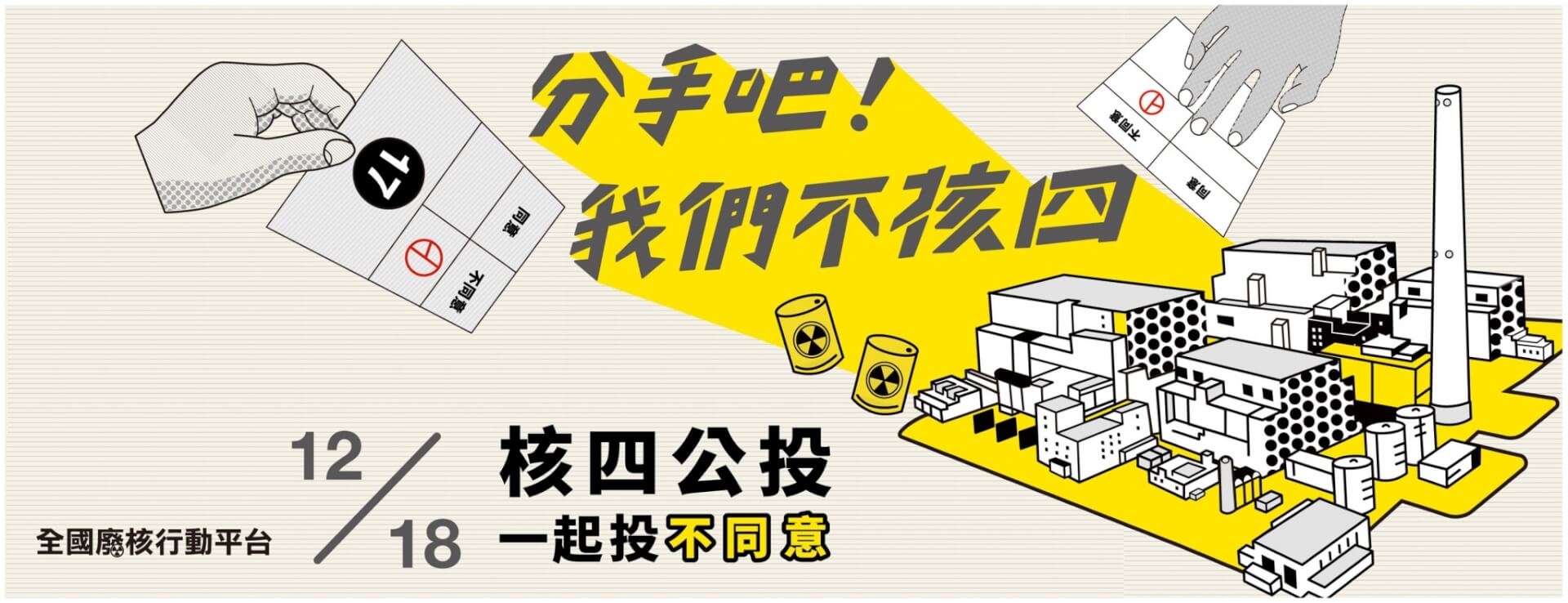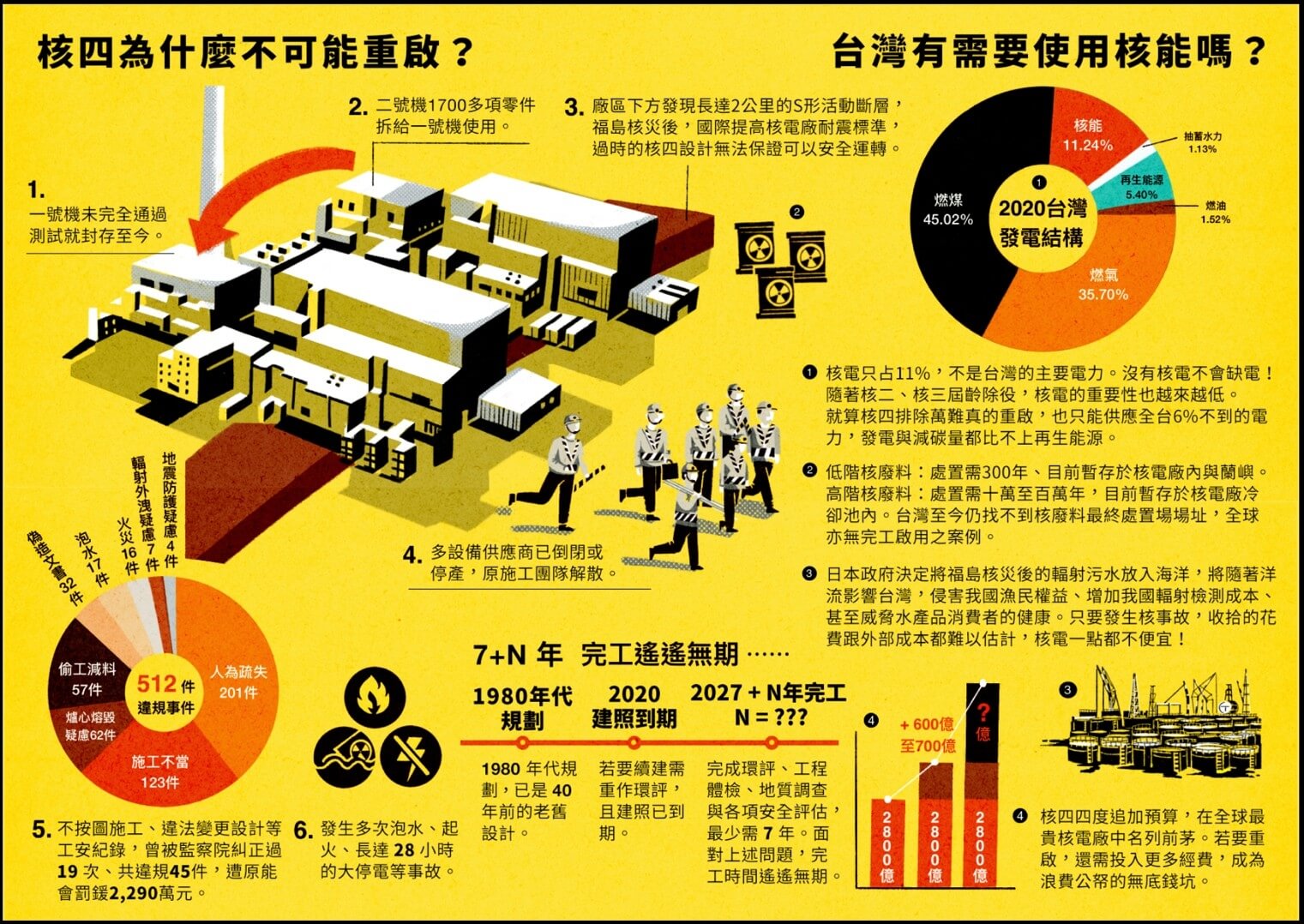
An open letter to environmental campaigners around the world from Green Citizens Action Alliance:
Taiwan votes to abandon the 4th nuclear power plant and to move toward energy transition
To our friends and partners around the world:
The end of 2021 marked a unique moment in the history of the nuclear-free campaign in Taiwan, since Taiwanese voted against the 4th nuclear power plant and put an end to a fight that has been lasting for more than three decades. We’d like to give you a snapshot of the outcome and thank you sincerely for your support over the past years.
A Clear “no” To A Dangerous NPP Near Active Geological Fault And A Highly Populated Capital Area
The resumption of the project of the fourth nuclear power referendum, colloquially known as the 4th nuclear installation referendum or ballot initiative 17, took place in Taiwan on 18 December 2021. The referendum asked whether the long-mothballed nuclear power plant should resume construction. With 41.09 per cent of the electorate turnout, Taiwan voted to reject the nuclear installation by a margin of 52.84 per cent to 47.16 per cent. Residents in GongLiao, district of New Taipei, in which the power plant was situated, delivered a resounding ‘No’ vote of 75 percent.
Taiwan is both densely populated and prone to earthquakes. Moreover, the country had all nuclear installations built on active geological fault lines and had all emergency planning zones designated within an eight kilometer radius of the existing nuclear facilities. Despite the fact that the 4th nuclear power plant sat directly on a potentially active fault zone, the main opposition KMT (also known as Chinese Nationalist Party) and the pro-nuclear camp falsely asserted that there were no new issues of concern to nuclear safety and that the nuclear installation warrants further funding from Taiwanese taxpayers. During the past year, ballot initiative 17 provoked a heated debate in Taiwan over the real social costs of nuclear power, seismic safety for existing and potential nuclear facilities, and radioactive waste management.
The victory of the ‘No’ vote in the 18 December referendum implies that the government of Taiwan led by President Tasi Ing-wen is legally obliged to move toward the abolition of the program of the 4th nuclear facility.
The initiation and development of the project of 4th nuclear power plant dates back to 1980 when the United States positioned itself as the world leader in both nuclear power and nuclear arsenal and subsequently pushed nuclear exports to its allies and protectorates. Despite the immediate aftermath of the Three Mile Island accident, triggering a cancellation of orders for numerous nuclear reactors around the world, this trend did not deter the KMT-led government of Taiwan from replicating the US model of electricity production and consumption. Prior to the project of the 4th nuclear, Taiwan had secured a fleet of six nuclear reactors constructed by General Electric Company under various turnkey contracts.
The construction of the 4th nuclear facility began in 1999. The initial cost of the project was NT$280 billion, approximately US$9.4 billion, in nominal terms. In contrast to the fleet of six units delivered by GE under turnkey contracts, the program of the 4th nuclear power plant was awarded by Taiwan Power, a state-owned utility, to more than 500 inexperienced contractors and subcontractors, preferring the use of temporary workers to the provision of long-term employment. Moreover, Taiwan Power hastened to deploy a highly complex combination of new and untested nuclear technologies developed by GE in reactor design.
Little wonder, from the onset of the program, the 4th nuclear facility had been mired in cost overruns, repeated delays, dubious construction practices, along with endless changes in reactor and plant designs. The shoddy construction by contractors and subcontractors of Taiwan Power drew widespread criticism from both senior nuclear engineers and the pro-nuclear corporate media.
The man-made Fukushima nuclear catastrophe not only shattered the delusion that nuclear facilities could never go wrong in democratic countries but also led to renewed interests in anti-nuclear campaigns in Taiwan.
These broad-based anti-nuclear campaigns which demanded a drastic change in policy immediately gained momentum and drew support from the various sections of the Taiwanese population.
Facing public anger over cost overruns, unresolved technical failure, and mounting evidence of cutting corners on safety requirements, the KMT government led by President Ma Ying-jeou was compelled to have the 4th nuclear installation mothballed in 2014. By the time the announcement was made, the 4th nuclear facility had become the biggest construction project in Taiwan and had been stretched over 15 years with construction accidents and arbitrary changes in reactor design becoming common occurrences.
Contrary to the KMT’s story about the construction of the 4th nuclear facility drawing to an end, the nuclear installation had suffered interminable delays since 1999. Indeed, there was no indication that the facility was fit for purpose. Nor was any sign that the installation could be made into a fully functional and safely run facility. It is no exaggeration to say that the very existence of the nuclear project and its scandalous mismanagement amounted to an unmitigated disaster.
With the acceleration of the climate crisis and the continuing increase in greenhouse gas emissions, supporters of nuclear energy started to proselytize the view that nuclear power was the answer to climate change and air pollution in Taiwan while omitting any reference to the environment destruction wrought by large-scale uranium mining. The KMT-aligned pro-nuclear campaigners subsequently attempted to resume the construction of the mothballed nuclear facility by initiating a referendum in 2020.
Coincident with the political maneuver, the construction license of the 4th nuclear facility expired on 31 December 2020. Since any resumption of the nuclear program would take at least a decade, this cast doubt on the claims about the effectiveness of nuclear power against air pollution and against the irreversible consequences of the climate crisis. It further raised the question as to what clean air benefits the costly and slow nuclear facility could deliver vis-àvis those done through the quick, easy and effective renewable alternatives.
It was quite noticeable that in the lead up to the 4th nuclear installation referendum, the slogan of nuclear being carbon-free, clean, climate resilient, and financially sustainable did not come from a scientific consensus of climatologists who called for drastic action, but from the KMT-aligned pro-nuclear groups, seeking to divert social resources away from a shift to an expansion of renewable energy infrastructure.
The ‘no’ vote, a debacle for both the pro-nuclear camp and the KMT, was the outcome of a four-decade long grassroots mobilization of environmental campaigners, activists, students, teachers and concerned citizens throughout GongLiao and beyond. Marking a watershed event in the anti-nuclear campaign of Taiwan, the referendum result represented both the final nail in the coffin of the program of the 4th nuclear facility and a significant step forward in Taiwan’s path to a future without nuclear power by 2025.
The government’s subsequent move in response to the referendum result has raised new concern over the conversion of an outdated electricity infrastructure to the one that is cleaner and lower-carbon. Prior to the referendum, the government hastened to underline that its program of energy transition by 2025 would entail 50 per cent of the country’s electricity coming from natural gas, 30 percent from coal, and 20 percent from renewable sources. Immediately after the referendum, the Taiwanese ministry of economic affairs made it plain on 3 January 2022 that the continued buildup of Taiwan’s manufacturing capacity since 2020 and the construction of semiconductor fabrication facilities contributed most significantly to a rise in electricity use.
With Taiwanese economic growth being revised upward to 6 per cent in 2021, the growth in electricity consumption was similarly revised up to 4 per cent. The result was that the program of energy transition has fallen short of its stated goal. Moreover, the government’s projection for electricity production made from renewable sources by 2025 was substantially revised downward from an earlier estimate of 20 percent to a new post-referendum 15.27 percent. This means that not only the target for energy transition is on the knife edge, uncertainty about Taiwan’s energy transition will likely give a boost to the KMT, which has never missed a chance to show its pro-nuclear credentials and to press for further renewal of licenses for the existing fleet of nuclear reactors.
While the people of Taiwan seemed to be supportive of the abolition of the 4th nuclear power plant, the narrow margin of the referendum and its historic low turnout some 40 percent (compared to the previous record low turnout of some 50 percent) also showed that Taiwan was deeply divided along partisan lines between the pro-nuclear KMT and the anti-nuclear DPP. It is clear that two major parties respectively utilized their house organs they controlled and whatever social resources available to rally supporters behind each camp. While the referendum came to an end, the open rift over how to make an orderly transition to a greener economy with less air pollution, less environmental damage and more sustainable growth has deepened since 2020. To move forward, the people of Taiwan should go beyond partisan politics and then find a common ground.
We are convinced that a transition to a low-carbon economy would occur only by design, not by default. The future lies in renewable energy. The infrastructure challenges are monumental, but they are ones of policy, not of technologies. It would be pragmatic for the government, environmental groups, and community organizers to raise the awareness about a massive deployment of clean energy infrastructure and to build strong interests in the construction of community-based power plants as an alternative to fossil fuels. With rationally planned land use and regulatory freezes on land speculation being put in place, agriculture and aquaculture sectors would reap substantial benefits from the deployment of renewable energy technologies at scale on their land. The desired impact can be done through the opening of space for constructive social dialogue, bringing in all stakeholders to explore all possible use of the land held by agriculture and aquaculture sectors. Lessons drawn from past experience suggest that the success of the expansion of renewable energy infrastructure, to a certain extent, hinges on its social acceptance.
While decoupling greenhouse gas emissions from GDP growth is difficult, it is achievable. We propose that with an annual GDP growth of 3 per cent, the annual growth rate of electricity consumed by the industrial sector must not exceed 1.3 per cent. In addition to the implementation of the nuclear phaseout by 2025, the government must commit itself to a long-running framework to decarbonize the whole economy. This would entail a rapid reduction in greenhouse gas emissions in both industry and transport, the implementation of a well-planned and coordinated retrofitting strategy in transportation systems, manufacturing sectors, along with commercial and residential buildings by the government. Moreover, private sectors must deliver sufficient investment in sustainable automation and design.
With higher levels of public participation and government oversight in public policy design and decision-making, more transparency and democratic accountability of governments and private sectors, along with clearer sustainability disclosure and reporting standards, this would then allow Taiwan to effectively drive emission cuts in industrial and energy-intensive sectors. The country will then follow in the footsteps of the US, Denmark and Germany to decouple economic growth from greenhouse emissions growth and usher in a transition to a green economy.
Sincerly,
Green Citizens Action Alliance,Taiwan




核電站-300x253.jpg)


-5-1-300x200.jpg)


